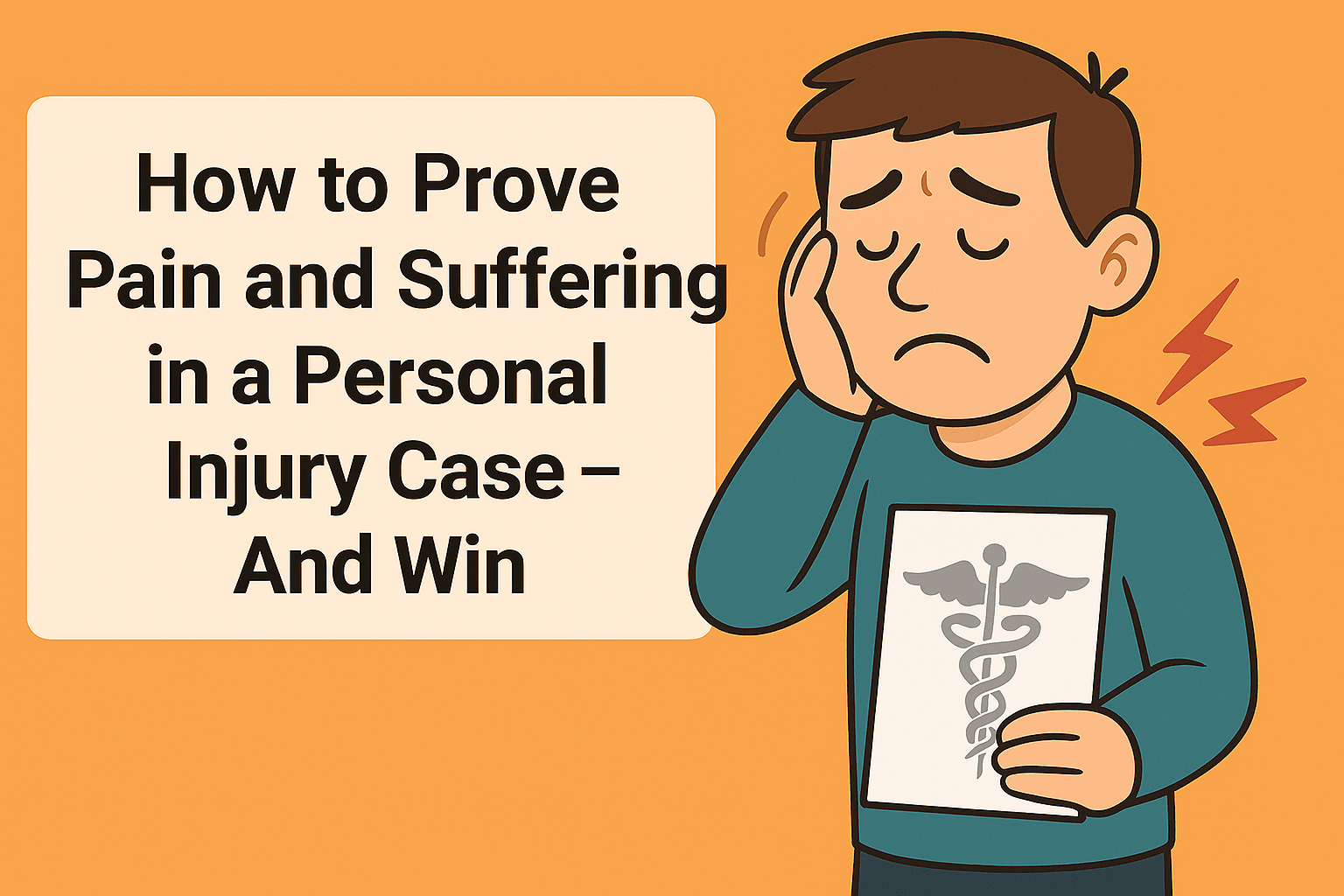

How to Prove Pain and Suffering in a Personal Injury Case – And Win
Introduction
Pain and suffering damages often represent the largest portion of a personal injury settlement, yet they're also the most challenging to prove. Unlike medical bills or lost wages that come with clear documentation, pain and suffering is subjective and intangible. How do you put a dollar amount on sleepless nights, chronic pain, or the inability to enjoy activities you once loved?
The key to winning substantial pain and suffering compensation lies in understanding what courts and insurance companies look for as evidence, then systematically building a compelling case that transforms your invisible suffering into undeniable proof. This guide will show you exactly how to document, present, and maximize your pain and suffering claim.
Understanding Pain and Suffering: What You Can Recover
Physical Pain and Suffering
- Chronic pain that persists after initial healing
- Ongoing discomfort from permanent injuries
- Pain from necessary medical treatments and procedures
- Physical limitations and reduced mobility
- Sleep disruption due to pain
Mental and Emotional Suffering
- Anxiety and depression following the accident
- Post-traumatic stress disorder (PTSD)
- Fear of driving or engaging in activities
- Loss of confidence and self-esteem
- Emotional distress from disfigurement or scarring
Loss of Enjoyment of Life
- Inability to participate in hobbies or recreational activities
- Reduced quality of life due to physical limitations
- Loss of companionship and consortium (for spouses)
- Missing important life events due to injuries
- Reduced earning capacity affecting life plans
The Challenge: Making the Invisible Visible
Why Pain and Suffering Is Hard to Prove
Insurance companies and defense attorneys often challenge pain and suffering claims because they can't be measured with traditional metrics. They'll argue that you're exaggerating, that your pain is subjective, or that your limitations are self-imposed.
The Burden of Proof
In personal injury cases, you must prove that your pain and suffering directly resulted from the defendant's negligence. This requires establishing both the existence of your suffering and its connection to the accident.
Strategy 1: Medical Documentation – Your Foundation
Comprehensive Medical Records
Your medical documentation forms the cornerstone of any pain and suffering claim. Without proper medical evidence, even the most compelling personal testimony may fall flat.
What to Include
- Emergency room records showing immediate pain complaints
- Diagnostic test results (X-rays, MRIs, CT scans) revealing injury extent
- Treatment records documenting ongoing pain management
- Physical therapy notes showing functional limitations
- Specialist consultations for chronic pain or mental health issues
- Prescription records for pain medication and antidepressants
Working with Healthcare Providers
- Be completely honest about your pain levels during appointments
- Ask doctors to document specific limitations in your medical records
- Request that healthcare providers note how injuries affect your daily activities
- Ensure mental health impacts are professionally documented
- Get referrals to pain management specialists when appropriate
Pain Scales and Consistent Reporting
Medical professionals use standardized pain scales to quantify your discomfort. Consistently report your pain levels and be specific about the type, location, and intensity of your pain.
Strategy 2: Personal Documentation – Building Your Case Daily
The Power of a Pain Journal
A detailed pain journal serves as contemporaneous evidence of your daily struggles and becomes one of your most powerful tools in court.
What to Record Daily
- Pain levels on a scale of 1-10 at different times of day
- Specific activities that cause or worsen pain
- Sleep patterns and quality of rest
- Mood and emotional state related to your injuries
- Medications taken and their effectiveness
- Activities you couldn't participate in due to pain
- Weather effects on your pain levels (if applicable)
Sample Pain Journal Entry Format
Date: March 15, 2024
Morning Pain Level: 7/10 - Sharp pain in lower back, difficulty getting out of bed
Activities Affected: Couldn't lift coffee pot, needed help getting dressed
Afternoon: 6/10 after medication, but pain returned by evening
Missed: Daughter's soccer game - couldn't sit on bleachers for extended period
Sleep: Woke up 4 times due to back spasms, total sleep approximately 4 hours
Emotional State: Frustrated and depressed about missing family activities
Photographic Evidence
Visual documentation can powerfully communicate your suffering to judges and juries.
What to Photograph
- Visible injuries at various stages of healing
- Mobility aids (wheelchairs, crutches, braces) you need to use
- Home modifications required due to your limitations
- Prescription medications showing the extent of your treatment
- Before and after photos showing your changed physical condition
Strategy 3: Third-Party Testimony – Voices of Credibility
Family and Friends as Witnesses
Those closest to you can provide compelling testimony about how your injuries have changed your life.
Effective Witness Testimony Should Cover
- Before the accident: Your typical activities, mood, and lifestyle
- Immediate changes: Observable differences in behavior and capabilities
- Ongoing impact: How your injuries continue to affect daily life
- Specific examples: Concrete instances of activities you can no longer perform
- Emotional changes: Personality shifts, depression, or anxiety they've observed
Professional Witnesses
Colleagues, supervisors, and business associates can testify about your professional limitations and career impact.
Workplace Impact Documentation
- Performance changes due to pain or medication side effects
- Missed opportunities for advancement or additional income
- Accommodation needs required to continue working
- Reduced productivity affecting career prospects
Strategy 4: Expert Testimony – Professional Validation
Medical Experts
Qualified medical professionals can explain the connection between your accident and ongoing suffering.
Types of Medical Expert Testimony
- Treating physicians explaining your diagnosis and prognosis
- Pain management specialists discussing chronic pain conditions
- Mental health professionals addressing psychological impacts
- Life care planners calculating future medical needs
- Vocational experts assessing career limitations
Economic Experts
These professionals can help quantify the financial impact of your reduced quality of life and earning capacity.
Strategy 5: Demonstrative Evidence – Showing Rather Than Telling
Day-in-the-Life Videos
Video documentation showing your daily struggles can be incredibly powerful evidence.
Effective Video Content
- Morning routines showing difficulty with basic tasks
- Physical therapy sessions demonstrating limitations
- Attempted activities that cause pain or are impossible
- Family interactions affected by your injuries
- Sleep difficulties and pain management routines
Technology and Apps
Modern technology offers new ways to document and prove pain and suffering.
Useful Tools
- Fitness trackers showing reduced activity levels
- Sleep monitoring apps documenting sleep disruption
- Pain tracking applications providing consistent records
- Mood tracking software showing emotional impact patterns
Strategy 6: Consistency is Key – Avoiding Common Pitfalls
Maintaining Credible Documentation
Your evidence must tell a consistent story across all platforms and timeframes.
Red Flags to Avoid
- Inconsistent pain reports between medical visits and personal records
- Social media posts that contradict your claimed limitations
- Gaps in treatment that suggest your pain isn't severe
- Exaggerated claims that medical evidence doesn't support
The Credibility Factor
Courts and insurance companies scrutinize pain and suffering claims for signs of exaggeration or fraud.
Building Credibility
- Be honest about good days and bad days
- Follow medical advice consistently
- Maintain treatment even when showing improvement
- Document both progress and setbacks honestly
Strategy 7: Legal Presentation – Making Your Case Compelling
Organizing Your Evidence
Present your pain and suffering evidence in a logical, compelling narrative that builds your case systematically.
Effective Case Structure
- Establish baseline: Show your life before the accident
- Document the trauma: Prove the severity of the initial injury
- Track the progression: Show how pain has evolved over time
- Demonstrate impact: Illustrate specific life changes and limitations
- Project the future: Discuss long-term implications and prognosis
Working with Your Attorney
An experienced personal injury attorney can help you present your pain and suffering evidence most effectively.
Attorney's Role in Proving Pain and Suffering
- Case strategy development tailored to your specific injuries
- Expert witness selection and preparation
- Evidence organization for maximum impact
- Negotiation tactics with insurance companies
- Trial presentation if settlement isn't achieved
Calculating Pain and Suffering Damages
Common Calculation Methods
The Multiplier Method
Multiply your economic damages (medical bills and lost wages) by a number typically between 1.5 and 5, depending on injury severity and impact.
Example: $50,000 in medical bills × 3 (severe injury multiplier) = $150,000 in pain and suffering
The Per Diem Method
Assign a daily dollar amount to your pain and suffering, then multiply by the number of days you've experienced and will experience pain.
Example: $200 per day × 365 days = $73,000 annually
Factors That Increase Pain and Suffering Awards
- Severity of injuries and long-term prognosis
- Age of the victim (younger victims may receive higher awards)
- Impact on daily activities and quality of life
- Professional and social consequences of the injuries
- Permanence of injuries and ongoing treatment needs
- Strong documentation and credible presentation
Common Mistakes That Destroy Pain and Suffering Claims
Documentation Failures
- Inadequate medical records that don't reflect the full extent of suffering
- Inconsistent pain reporting across different healthcare providers
- Missing mental health treatment for emotional trauma
- Poor journal keeping with sporadic or incomplete entries
Behavioral Mistakes
- Social media activity that contradicts claimed limitations
- Refusing recommended treatment that could help your condition
- Returning to activities too quickly without medical clearance
- Inconsistent statements to different parties about your condition
Legal Missteps
- Settling too early before understanding full impact
- Inadequate expert testimony to support claims
- Poor presentation of evidence to insurance companies or courts
- Unrealistic expectations about potential awards
Working with Insurance Companies
Understanding Their Tactics
Insurance adjusters are trained to minimize pain and suffering payouts through various strategies.
Common Insurance Company Arguments
- "Your pain is subjective and can't be verified"
- "You're exaggerating your symptoms for financial gain"
- "Pre-existing conditions are causing your current pain"
- "You could return to normal activities if you wanted to"
- "Your treatment is excessive for the type of injury you sustained"
Countering Insurance Tactics
- Provide objective evidence supporting your subjective claims
- Maintain consistent documentation across all platforms
- Follow all medical advice to show you're serious about recovery
- Avoid giving recorded statements without legal representation
- Let your attorney handle negotiations to avoid damaging admissions
Maximizing Your Pain and Suffering Award
Building the Strongest Possible Case
- Start documenting immediately after your accident
- Seek comprehensive medical care including mental health treatment
- Maintain detailed records of all impacts on your life
- Gather supporting testimony from family, friends, and colleagues
- Work with qualified experts to validate your claims
- Present evidence professionally through experienced legal counsel
Timing Considerations
- Don't rush to settle until you understand the full scope of your injuries
- Wait for maximum medical improvement before finalizing agreements
- Consider long-term implications of your injuries on future earning capacity
- Account for inflation in calculating future damages
Negotiation Strategies
- Present comprehensive evidence package to insurance companies
- Use comparable case awards to support your demand
- Be prepared to go to trial if necessary for fair compensation
- Consider structured settlements for long-term financial security
The Path to Victory: Your Action Plan
Immediate Steps (First 30 Days)
- Seek comprehensive medical evaluation including mental health screening
- Begin detailed pain journaling immediately
- Photograph visible injuries and any mobility aids needed
- Contact qualified personal injury attorney for case evaluation
- Notify close family and friends to begin observing and documenting changes
Short-term Actions (First 3 Months)
- Establish treatment relationships with necessary specialists
- Maintain consistent medical care and follow all recommendations
- Document work-related impacts and lost opportunities
- Begin gathering witness statements from family and colleagues
- Avoid social media or be extremely cautious about posts
Long-term Strategy (Throughout Your Case)
- Continue comprehensive documentation of all impacts
- Build relationships with treatment providers who can testify on your behalf
- Work with attorney to develop expert witness strategy
- Prepare for depositions and testimony with legal counsel
- Stay patient through the legal process for maximum recovery
Conclusion: Transforming Suffering Into Justice
Proving pain and suffering in a personal injury case requires a comprehensive, strategic approach that transforms your invisible suffering into compelling, admissible evidence. The key is starting early, staying consistent, and working with qualified professionals who understand how to present your case effectively.
Remember that pain and suffering damages serve an important purpose beyond compensation – they hold negligent parties accountable and provide the resources you need to rebuild your life. By following the strategies outlined in this guide, you'll be well-positioned to prove your pain and suffering and win the compensation you deserve.
Your suffering is real, your impact is significant, and with proper documentation and presentation, your case can be both compelling and successful. Don't let insurance companies minimize your pain or rush you into inadequate settlements. Take the time to build your case properly, and fight for the full compensation that reflects the true cost of your injuries.
Disclaimer: This article is for informational purposes only and does not constitute legal advice. Pain and suffering laws vary by jurisdiction, and every case is unique. Consult with a qualified personal injury attorney in your area for advice specific to your situation and local laws.










